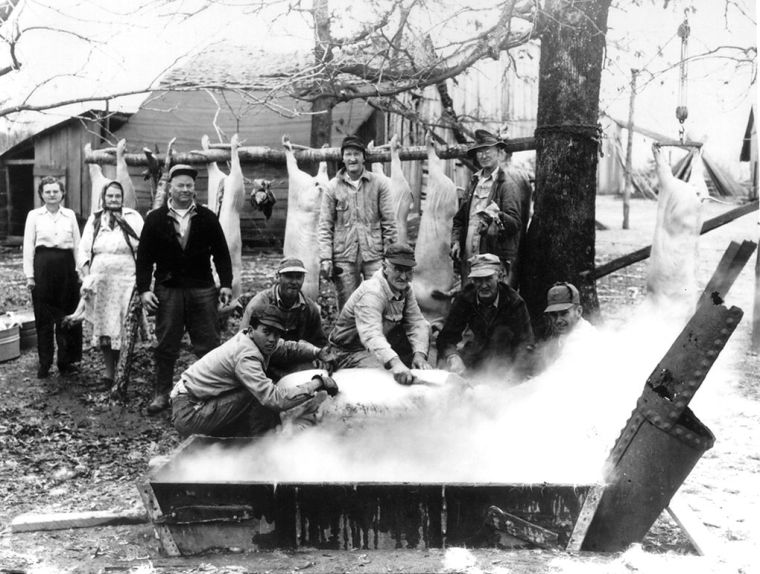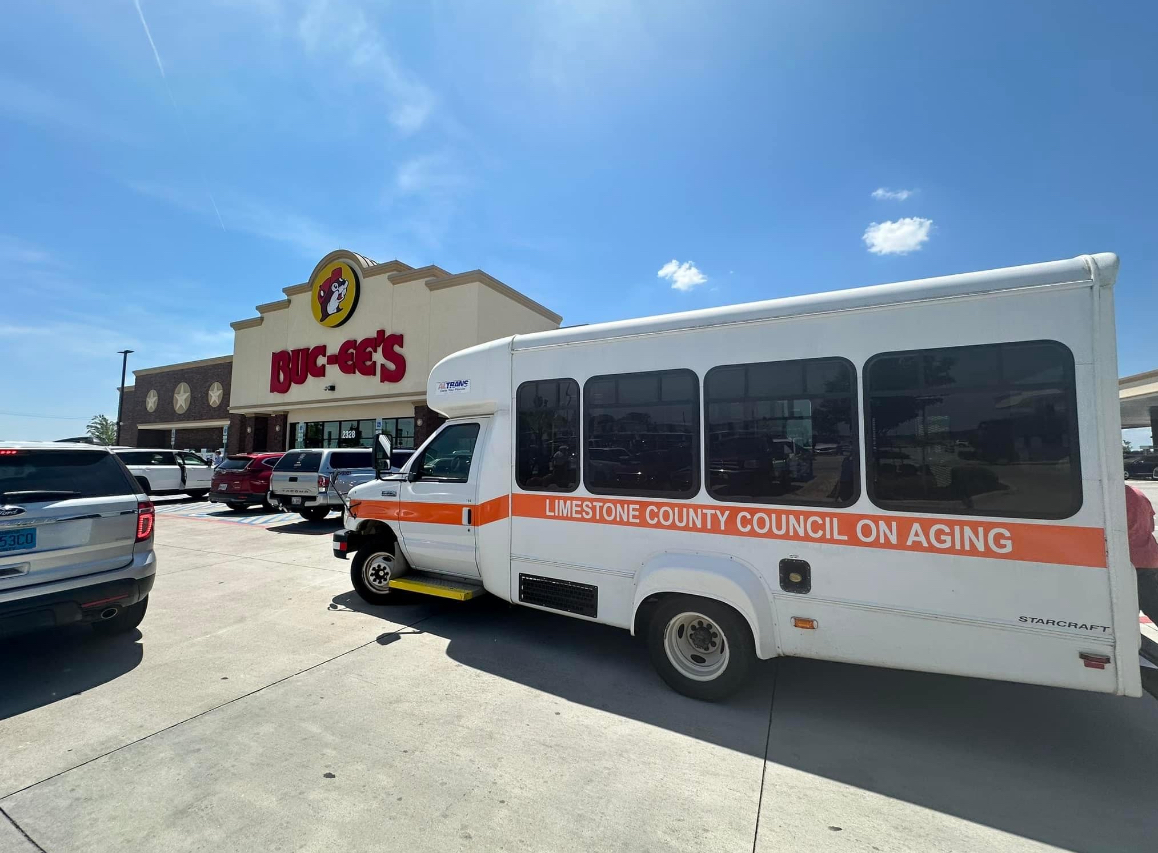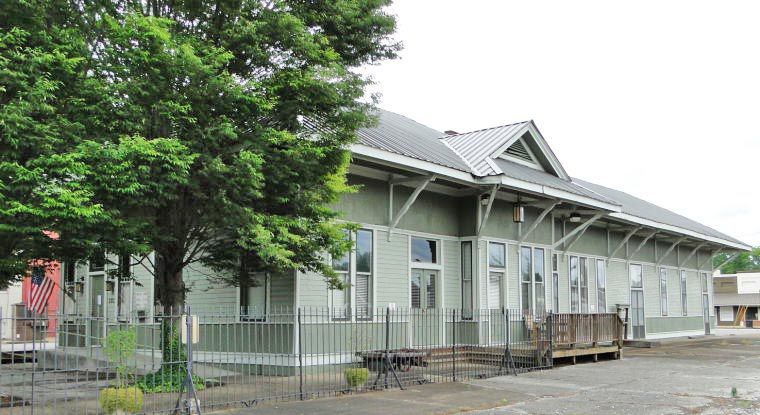When hog killing day was held each Nov. 20
Published 8:18 pm Saturday, November 17, 2007

- Gathered at a community hog killing at Brown’s Corner off the upper end of Mooresville Road are, front row from left, Harold Norton, his father Al Norton, Clarence Tucker, Arthur Bowers and Pete Brown; back row, Florence Brightwell, Sue Ella Hall Brown, J.T. “Red” Brightwell, Luther Meadows, and G.W. Brown. The photo was taken at the home of G.W. and Sue Ella Brown. The scalding vat sat over a fire pit.
Across Elk River, 1946.
A bumping noise woke Gene Foust. He looked around the dark, cold room, burrowed deeper beneath the quilts, seeking his warm spot, and pondered the noise.
The sounds came from the kitchen where his father, Euly Foust, was stoking the wood stove and his mother, Madglene, was preparing breakfast.
Then he remembered. It was November 20th, a special day for any 8-year-old country boy. Hog killing!
Gene swung out onto the cold linoleum, pulled overall straps over his shoulders, grabbed his brogans and tore out to the kitchen where it was warm and his mother was cutting out biscuits. Coffee gurgled and bacon sizzled in a black skillet.
As long as he could remember, his father and Mr. Roy Garner and other neighbors had killed hogs on November 20th, that is, if it didn’t fall on Sunday.
His father sipped his coffee. “It’s cold, but not freezin’,” his father said. “Just right for killing hogs.”
After breakfast, his father grabbed a sharp-pointed butcher knife and his .22 rifle. With Gene trailing behind, he headed out the back door in the cold morning to the weathered barn where the mules were stabled.
In a nearby pen, three hungry hogs, unfed the previous evening, squealed for food. His father wanted their stomachs empty when they were slaughtered. They hitched the mules, Emma and Nina, to the wagon and pulled around to the pen andthe three, 350-pound hogs.
They herded the hogs into a small holding pen where corn kernels were sprinkled. His father loaded the .22 rifle and backed off several yards. “Pow!” A big hog dropped, small hole between his eyes.
Quickly, he shot the other two hogs. He set his rifle down and picked up the butcher knife and stuck each hog in the throat, severing the main artery. They used a block and tackle to load them onto the wagon.
Gene climbed onto the wagon seat next to his father, who clucked to the mules, “Giddy up.”
The wagon creaked forward under the half-ton load and slowly moved up Smith Hollow Road toward Lester Road where Roy Garner lived.
His father had been reared east of Pulaski. He married Madglene Long and they moved to Euly White Hollow in the rolling hill country near Lester when Gene was only 4 or 5 weeks old. Later, they moved to Smith Hollow. His father grew cotton on the good land and corn on the hillsides. The hills were so steep that to prevent the wagon from tipping over when they gathered corn, his father fastened a long pole under it. Gene sat on the end of the pole to balance the wagon. He could remember jumping off more than once when the wagon began turning over.
They reined up at Garner’s place where a scalding box filled with steaming hot water was positioned over dancing flames near a small branch that ran in front of his house. Neighbors, Bob Coffman and his son, W. C. Coffman, Loaford Long and Alvin McCluskey were there.
Gene, now 69 and employed at the Limestone County Sheriff’s Department as a correctional officer, remembers the hog-killing days of his youth well.
“The scalding box was about 3-by-5 feet and was made of poplar,” he remembers. “Tin was rolled under the bottom from the back all the way to the front and some yellow poplar two-by-fours went across the bottom, sort of far apart. Two big crooked nails on the outside hooked into yellow poplar to which trace chains were attached. That was used to roll over the hog.
“To get your water hot to scald the hogs, you had to pull your fingers through it three times slowly and that third time if you couldn’t hardly get it through the water, it was just right.”
The hog was lowered into the scalding water, feet and stomach down.
“There would be two of you standing astraddle the box,” says Gene. “You’d have an end of the chain in each hand. You let them lay on that side a little bit and then you’d roll him with the chain back to the other side.”
The hog remained in the scalding water for about 15 minutes or until the hair could be twisted off the feet and face by hand.
“Daddy was always the hair twister. You’d roll the hog over on his back and his feet would stick up and Daddy would twist the hair off his feet, the head and around the mouth and eyes.”
Next, the hog was rolled out of the scalding box on two 1-by-6 planks where someone removed the rest of the hair from the feet and face by twisting and scraping with a butcher knife.
“After the first one was cleaned, you gambled it,” says Gene. “You took a hickory stick about 2 feet long that was sharp on both ends, which was inserted through a leader in the back leg next to the foot.”
Four or five men then hung the hog, head down, onto a horizontal pole, called a gambling pole.
“Mr. Roy was always the gut’er,” says Gene. “He would wash the hog down, then split ‘em open and wash out the insides. He kept the liver and the rest of the organs were thrown into a tub and dumped somewhere. He’d cut out a section of rib, then cut out the tenderloin. At about 11:30 a.m. we would have our three hogs done and two of Mr. Roy’s completed. His wife would come down and get a set of tenderloins and cook ‘em for our dinner and we’d have a break.”
After lunch, five or six more hogs would be scraped and gutted and then each family would carry them back to their house to be dressed out.
Returning home, the Fousts put paper and cardboard on their seldom-used dining room floor where they unloaded the three hogs. After supper they milked 10-15 cows by hand and fed four head of horses and mules, then began dressing out the hogs.
“Well, usually we’d pull them open and with a chopping axe cut down each side of the backbone and through the rib cage,” says Gene. “You’d halve them. You didn’t split the backbone ‘cause the old folks wanted them boiled backbones. Then you’d cut the front quarters, which was called the shoulders, then you’d cut out the hams and then you’d cut out the midlins.
“After it cooled, you started trimming it with a butcher knife—get the fat off. Some was used to make sausage. The hog’s head was split open with an axe and the brain extracted,” says Gene. “Mama would boil the head and get all the meat off to make souse meat out of it.”
Here’s some more stuff you make from a pig:
• Cracklins. “You put the fat trimmings in a big old black kettle over a fire in the backyard and you cooked it until you had cracklins. Most of the lard was the fat part right under the skin of the hog. You would just cut it up in inch-and-a-half squares and drop it in the kettle and it would get to boiling and all the grease would cook out of that. You stirred them with a paddle and when the cracklins got cooked down they would float to the top. You’d get one out and sample it to see if it had any grease left in it and needed cooking a little bit longer. And if it was dry enough, you would dip out some of ‘em into a white cloth and twist the ends one way and then the other way to squeeze the lard out.
• Lard. After the cracklins were dipped from the iron kettle, lard remained. “You dipped it out and put it into 50-pound lard stands. You left the lid off until it cooled because if you didn’t it would build up pressure and blow the lid off. We usually got two to three stands out of 3 hogs.”
• Souse. “The day after we made lard, a fire was built around the iron kettle and Mama put the whole hog head in there and she’d let it sit there and bubble and boil, add some water in it until it was just like a stew. All the meat come off the bone and then she’d take that meat that come off the head and would grind it up in the sausage grinder, add salt and black pepper and red pepper. She’d pack it in a bowl and put a plate on top to mash it down to keep it firm. She usually had a big old cup; she’d fill it full of water and set it on that plate to hold pressure on it until it really sealed out. In a couple of days it would slice out just like a stick of bologna.”
• Hog brains. “After you cut the head off, you’d split the head open a little bit and you get the brains out. She put a little grease in a skillet and fried the brains. When they started getting brown she’d break her eggs and put them in there and scramble it all up together.”
• Pickled pigsfeet. “Now, you took the hooves off up on the leg at the first joint, which I call the feet, and she would pack them in a big-mouth jar. She had some vinegar, salt and water concoction, which she’d fix up and pressurized it and the jar would seal. They were sticky, and waxy like but had a good taste.”
• Backbone. “The backbone didn’t have much meat on it, but what was on it was real good and sweet. They cut it up in about three joints, stir in a little grease and water and just let it boil until it got tender enough to eat. You just pulled if off the bone and eat it.”
• Salting meat. “We had a salt box that was about 3 foot wide and 4 or 5 foot long and about 3 feet deep, made of solid wood. You’d put a layer of salt in the bottom, then put your hams down first, because that was the last meat you’d eat. Sprinkle salt on them and put your shoulders down next and sprinkle salt on them. Next, you put the midlins down and covered them all good with salt. You left them in there about 6 weeks. Then you took them out, raked off the salt and take baling wire and stick a little hole in the meat and hang them from the rails in the smoke house.”
• Sausage. A sausage grinder was fastened to the edge of a table and a dishpan was placed beneath it. The lean meat trimmings were fed into the grinder as someone turned the handle. “Mama would take the ground meat and add her salt, pepper and sage. You always put sage in your sausage to give it the flavor. She would then work it up and she always had a hot skillet and she’d drop a little ball in there to make sure it had everything in it. She was the sampler. Then when she got the sausage done, she balled it into balls a little bit bigger than a softball, and you put it in a brown sack. You would twist the top of it up and tie a string around it and then tie that around your pole in the smokehouse and you hung it up so the rats couldn’t get it.
“The sausage wouldn’t ruin. I’ve seen it taken out of those bags and it would have mold on it. It would turn plum green on the outside it had been there so long but you could peel it like an apple and when you peeled it off the inside was just as pretty and bright as the day you put it in there.
“Mama canned some sausage. She’d pat them out in sausage size and she’d run them through a steaming process and then she’d put them in a quart fruit jar and she’d put them in a cooker and process them so long in that under pressure. They were good that way but not near as good, I didn’t think, as what you got out of a bag and fried.
“I’ve had some of everything of the pig except the hoof,” says Gene. “I have eaten cracklins, I have eaten chitlins, I have eaten the meat off the backbone. Didn’t have nothing to throw away. Back in those days you preserved everything you could because money was short and you wasn’t able to just run to the supermarket. Well, they didn’t have a supermarket. You could buy stuff off the peddling truck.”
Gene and wife, Lynda, live on Craig Chapel Road not far from where he killed hogs as a child. “And I still enjoy pork,” he says.





